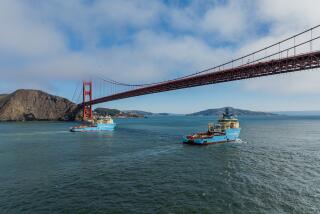Report Says Convair Lagoon Cleanup Cost May Reach $90 Million
- Share via
Teledyne Ryan Aerospace says it could cost as little as $5 million or as much as $90 million to clean up a San Diego Bay lagoon laced with its industrial waste, including cancer-causing toxins, according to a report filed with the Regional Water Quality Control Board.
In the report, filed Friday for consideration at the board meeting Monday, Teledyne Ryan said any of the three cleanup options it had identified for Convair Lagoon, an inlet east of Harbor Island, would take at least 1 to 2 years--not counting the time to fix the storm drain network through which the waste filtered into the bay.
The board’s only action Monday on the report was to confirm Teledyne Ryan’s fine of $17,500 for being nearly two months late in filing it, about a third of the maximum amount the firm could have been penalized. It is unclear when the board will respond to the report, the company’s lawyer, Donald J. Wilkins, said Monday.
The price projections mark Teledyne Ryan’s first estimates on the cost of cleaning up the sediment in Convair Lagoon, which studies indicate has the highest recorded levels on the West Coast of cancer-causing polychlorinated biphenyls, or PCBs.
Discharged during rainstorms from company transformers and hydraulic fluids, the PCBs made their way into the storm drains and the bay, the water board has found.
Wilkins also stressed that the cost estimates were tentative, particularly the $90-million figure, which he said was the high side of one of the three options--dredging and removing contaminated sediment.
The other two options, according to the report, are capping the sediment with a permanent barrier--in essence, sealing it from future contact--or a combination of both dredging and capping.
“These are very, very preliminary numbers, to get a sort of ballpark figure,” Wilkins said. “A great deal more engineering needs to be done to come up with a firm number. So anything that’s included has to be taken with that in mind.”
Environmental activists said Monday they were disappointed with what was not included in the report. Laura Hunter, a spokeswoman for the San Diego-based Environmental Health Coalition, said the board should not limit itself, as Teledyne Ryan did, to three options.
“One of the things we are thinking of is that there are many alternatives,” she said. Options might include washing the sediment, burning the PCBs in a closed system that would produce no air pollution or releasing biological agents that would “eat” the PCBs, she said.
“We don’t know how many (options) there are,” Hunter said. “Some of them might be cheaper. Some might be more expensive. Our position is that these have not been looked at. And they should.”
Wilkins said Teledyne Ryan said dredging and removing the soil could cost $27 million to $90 million. It put the cost of capping at $9 million to $14 million. And it said a combination of the two could cost $5 million to $15 million.
It is also unclear whether Teledyne Ryan would have to shoulder the cleanup cost alone. So far, it is the only firm that has received a water board cleanup order.
“We feel there are certainly other potential contributors,” Wilkins said, adding “that’s an issue that will have to be addressed” in the future.
Wilkins said Teledyne Ryan will pay the $17,500 fine, which the board had issued Jan. 4 for missing the Nov. 30 deadline it had set for filing the report.
Environmental Health Coalition officials asked the board Monday to raise the administrative penalty to $55,000, the maximum amount possible, to remind the company that the deadline was important.
The panel instead confirmed the $17,500 fine. Staff members told the board Monday that Teledyne Ryan officials had simply been late, not stubborn, and had met the deadline the company had said it could meet--last Friday.
Teledyne Ryan officials had opposed any fine, saying the board didn’t even ask for the report until Oct. 10, leaving the company only six weeks to meet the deadline. The company wanted to line up experts around the country, Wilkins said, and “obviously those folks are not available at the drop of a hat.”
More to Read
Inside the business of entertainment
The Wide Shot brings you news, analysis and insights on everything from streaming wars to production — and what it all means for the future.
You may occasionally receive promotional content from the Los Angeles Times.










